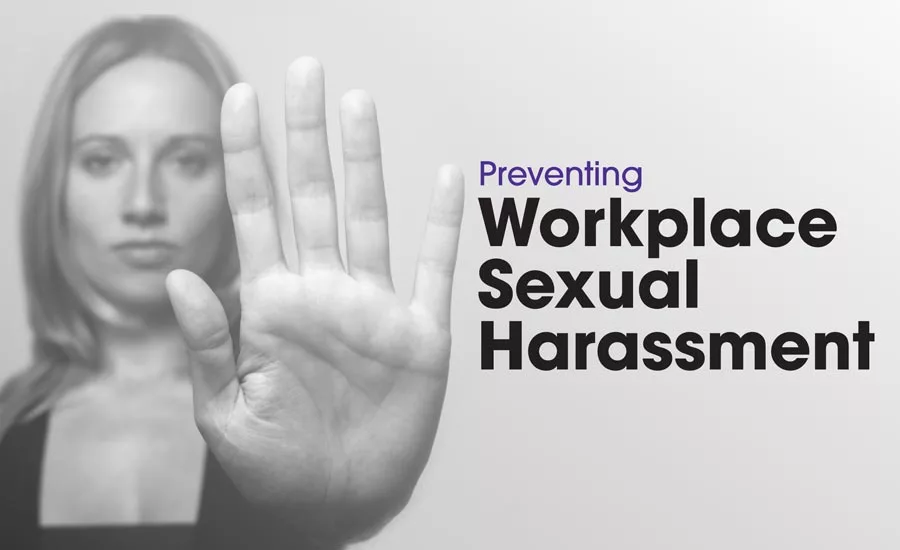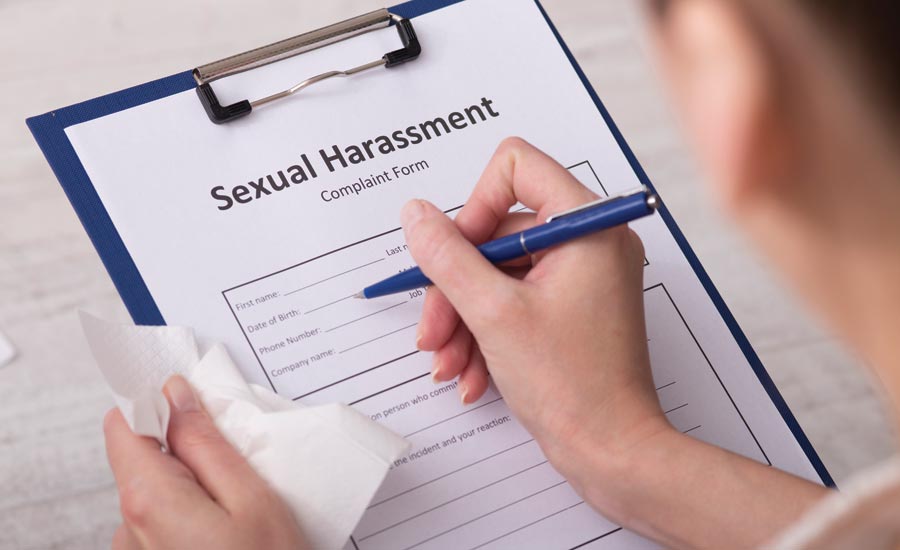Preventing Workplace Sexual Harassment

For anyone who has experienced the unthinkable, 2017 will forever be known for one powerful, yet devastating hashtag: #MeToo. So much so that TIME magazine named the social movement it’s Person of the Year. Seemingly overnight reports of inappropriate behaviors of high-profile celebrities, famous politicians, and influential business owners disgraced their careers while victims found strength through a burgeoning, unified voice.
Sexual harassment in the workplace is not confined to Hollywood elites or Fortune 1000 corporations. Small businesses, including some within the disaster restoration industry, have been hit with charges and lawsuits. Now, more than ever, it is imperative that we work to prevent workplace harassment through awareness, strict policies, and when appropriate, swift and serious action.
The U.S. Equal Employment Opportunities Commission (EEOC) defines sexual harassment as a form of discrimination that violates Title VII of the Civil Rights Act of 1964. The Act prohibits unfair employment practices and discrimination based on sex (including pregnancy, gender identity, and sexual orientation), age (40 and older), color, national origin, race, religion, disability or genetic information. Sexual harassment specifically consists of unwelcomed conduct and behavior of a sexual nature that creates an uncomfortable and often hostile work environment to a reasonable person. Congress has continued to amend the Civil Rights Act of 1964 including, in 1991, allowing victims to recover compensatory damages beyond back pay, which can include damages for emotional pain and suffering, mental anguish, loss of enjoyment in life, and more.

Sexual harassment specifically consists of unwelcomed conduct and behavior of a sexual nature that creates an uncomfortable and often hostile work environment to a reasonable person.
Two Types of Sexual Harassment
There are two types of sexual harassment under which the U.S. Supreme Court has identified and punished companies. The most well-known is Quid Pro Quo or “this for that.” It occurs when a person in power promises job-related benefits in exchange for sexually-related favors, such as an employee being offered a promotion if they are willing to go on a date with a higher up. Quid Pro Quo cases are easy to define, allowing courts to use the doctrine of respondeat superior, Latin for “let the master answer,” that has roots all the way back to ancient Rome. In modern terms, it means a company is liable for a supervisory person’s actions if they are considered an authority figure by said company or by the victim. This pertains even if the person is an agent of the company—not an actual employee. If you are an employer and haven’t taken the proper steps for prevention, this should keep you up at night, as you could be liable for the actions of people you don’t directly employ.
The other type of sexual harassment is more common, but also more difficult to define and prove. A Hostile Work Environment occurs when intimidating, offensive, demeaning, or abusive comments and/or conduct takes place. It doesn’t matter at what level the employee is who engages in the behavior. It can also include actions taken by vendors, customers, or others commonly found within the workplace environment. Agreed examples of a Hostile Work Environment include repeated crude and inappropriate jokes and comments, displaying pornographic or sexually suggestive pictures, and unwanted sexual advances, including touching.
The rate at which workplace sexual harassment occurs is alarming. A recent study by the EEOC shows four out of every 10 women reported being a victim. Nearly 13,000 sexual harassment complaints were filed with the EEOC in 2016 alone, despite an estimated 75 percent of workplace incidents going unreported each year. In small businesses where a victim may only have one supervisor and no HR department, it is far more likely for incidents to go unreported out of fear that anonymity is not possible.
Most experts agree the #MeToo movement will encourage and inspire a higher percentage of victims to go public, hopefully forcing companies to deal with this damaging issue head-on instead of a “hope it doesn’t happen here” approach. More victims going public, regardless of company size, means an increased chance of incidents being reported in small businesses. Since the restoration industry is comprised mostly of small businesses, this means sexual harassment claims are likely to rise.
Restoration companies have a legal obligation to take reasonable actions to prevent workplace sexual harassment. While legislation has limited the maximum amount of compensatory and punitive damages, the amounts still range from $50,000 to $300,000 depending on the number of employees in the company. Companies with more than 15 employees fall under federal law, while smaller companies are dealt with by local and state governments.
Defining Sexual Harassment
Other than blatant actions that most of us would recognize as inappropriate, what is considered sexual harassment in the workplace? Is an employee allowed to ask another on a date? Where is the line between an acceptable or unacceptable joke or comment? If an employee compliments the way an outfit looks on another employee, could that legally be defined as harassment? The answer isn’t always clear. Courts have continued to struggle with what is and is not acceptable and their rulings have been inconsistent.
While not all-inclusive, according to the EEOC’s website, the following points regarding workplace sexual harassment have been agreed upon:
- The victim as well as the harasser may be a woman, or a man, and the victim does not have to be of the opposite sex. (16% of complaints are filed by men)
- The harasser can be a supervisor, agent of the employer, a supervisor in another area, a co-worker, or a non-employee.
- The victim does not have to be the person harassed but could be anyone affected by the offensive conduct.
- Unlawful sexual harassment may occur without economic injury to, or discharge of, the victim.
- The harasser’s conduct must be unwelcomed.
It doesn’t matter if a joke wasn’t meant to offend, or if the comment or action took place after hours. It is still the responsibility of business owners and managers to create a safe workplace for all employees, 100 percent of the time. A business is liable even if company owners and managers are unaware the harassment is happening.

The first step in stopping sexual harassment in the workplace is to take a proactive stance toward prevention.
Establishing an Anti-Harassment Policy
Unfortunately, when it comes to claims of sexual harassment, percentages show it’s not a matter of if it will happen in our companies, it’s a matter of when. The first step in stopping sexual harassment in the workplace is to take a proactive stance toward prevention. Companies need to institute a comprehensive and detailed anti-harassment policy. The policy should comply with local, state, and federal mandates and be included in the employee handbook, along with being prominently displayed throughout the workplace. It is recommended that policies include the following:
A definition of workplace sexual harassment that coincides with the EEOC
- An organizational commitment to eradicate and prevent sexual harassment
- Examples relevant to the business environment
- An explanation of penalties (including termination) the employer will impose for sustained sexual harassment conduct
- A clear procedure on reporting infractions, including how and to whom
- A written statement on how the company will address harassment claims
- Affirmation that the company prohibits any type of retaliation
- An expressed commitment to keep all sexual harassment complaints and actions of personnel confidential
- Additional resources or contact persons available for consultation
A key piece of preventing workplace harassment is to sensitize everyone to terms, phrases, and behaviors that can be seen as hurtful, disrespectful, and illegal. Consider hiring a certified trainer to conduct an educational seminar on awareness and prevention. Take steps to communicate your company policy, and require all employees to read and sign off on it. Make sure everyone is included in a policy roll-out meeting and allow them to ask questions for better understanding. For a policy to be effective, it is critical for companies to take sexual harassment seriously and to enforce its policy vigorously and consistently.
Handling Complaints
All complaints of harassment must be fully investigated, and maintaining the confidentiality of anyone who files a complaint is paramount. Realize that both the speed and the effectiveness of how a claim is investigated may have a direct impact on a company’s overall liability from a legal and punitive standpoint. Hold all employees to the same measures regardless of role or personal relationship. It is important that the person investigating a claim does not reach a conclusion until they have all the facts. Unconscious bias can lead to major mistakes in judgement. Do not object if the employee who files the claim prefers to bypass the standard chain of command. Be sensitive to the fact that they may be feeling hurt, scared, angry, or embarrassed. Never allow retaliation against a victim to happen. Courts often come down even harsher against companies that retaliate. Encourage management to lead by example in their daily interactions with others. Employees who see a superior cross the line may be quick to mimic their actions. Most importantly, document the entire review process and be sure to save it in a safe and confidential location. You can never have too much documentation.

The Gender Gap
Let’s be honest. Though not to the extreme it once was, restoration is still a male-dominated industry. And while both men and women have experienced workplace sexual harassment, according to studies by the Harvard Business Review, it is far more likely to occur in male-dominated environments. One of the most effective ways to limit workplace sexual harassment is by having more women at all levels in an organization. When restoration business owners make a concerted effort to hire and promote qualified women, they close gender gaps in their organization and create a more diverse and stronger team. Plus, studies have shown women are more likely to excel at listening, customer service, and empathy—all important qualities needed in restoration.
Don’t think this means that women never harass men. There have been many successful lawsuits filed by men against women. There are also quite a few involving harassment of the same sex or involving those of different sexual orientations. Several well-known cases involve gay men filing suit after being offended when women hung up pictures from men’s fitness magazines in their cubicles.
When in Doubt, Act!
As a business owner or manager, employees trust you to provide a safe working environment. Imagine having to tell your significant other that you allowed sexual harassment to happen in your company and now are being sued for hundreds of thousands of dollars. You may have employees who will commit actions or make comments that could get them into trouble for the rest of their lives because they simply didn’t know better. You can help them before this happens.
Most importantly, we need to try to understand the emotional pain a victim suffers and put ourselves in their shoes. Their lives will never be the same. As a business owner, you must act. Even if your company can survive the financial penalties, your customers and community will eventually find out and it will ruin your reputation. #MeToo is real. The pain caused by workplace sexual harassment is devastating. As a business owner, it is important to make sure there is nothing going on in your company that is not okay. Don’t let thoughts like, “he’s a good guy, he didn’t mean anything by it” or “she’s just being overly sensitive” cloud your judgement. Do a gut check, and when in doubt—act.
*Note: Neither of the authors of this article are attorneys. The purpose of this article is to bring awareness of a significant workplace issue and provide some insight into prevention and protection. If you or someone you know is a victim of sexual harassment in the workplace, please contact an HR representative, company owner or supervisor, or a licensed attorney.
Looking for a reprint of this article?
From high-res PDFs to custom plaques, order your copy today!








